Study of the Spatiotemporal Variation Characteristics of Forest Landscape Patterns in Shanghai from 2004 to 2014 Based on Multisource Remote Sensing Data
Abstract
1. Introduction
2. Study Areas and Materials
3. Methodology
3.1. Urban Forest Landscape Classification Based on Remote Sensing Data
3.2. Spatial Analysis of the Forest Landscape Pattern
3.2.1. Urban and Rural Gradient Division Method
3.2.2. Urban Forest Landscape Analysis Method Based on the Landscape Index.
3.2.3. Urban Forest Landscape Analysis Method Based on Ripley’s K
4. Results
4.1. Overall Spatial Patterns of Urban Forests in Shanghai from 2004 to 2014
4.1.1. Overall Distribution of Urban Forests in Shanghai
4.1.2. Spatial Analysis of Urban Forest Landscape Patterns in Shanghai
4.2. Analysis of the Evolution of Multiscale Features of the Urban Forest Landscape in Shanghai
4.2.1. Spatial Pattern of the Urban Forest Landscape with an Urban and Rural Division
Spatial Pattern of the Urban Forest at the Landscape Level
Spatial Pattern of Urban Forests at the Class Level
4.2.2. Analysis of the Multiscale Agglomeration Characteristics of Urban Forest Landscape Patterns
5. Discussion
5.1. Evolution of the Spatial Distribution Pattern of Urban Forests in Shanghai
5.2. Discussion of the Factors Affecting Urban Forest Evolution in Shanghai
6. Conclusions
- (1)
- The urban forest landscape and its patch characteristics meant that the spatial information surveys of the urban forest landscape had to rely on modern information technology, combined with multi-source remote sensing data, RS and GIS technology for urban forest landscape surveys. In addition, automatic/semiautomatic extraction is an inevitable trend and a requirement to obtain the time series of urban forest classification information. According to the research, using remote sensing big data combined with forest resource survey business data, the accuracy of the semiautomatic interpretation results generally met the research and analysis needs. The spatial morphological characteristics of the terrestrial patches obtained by this interpretation were spatial reflections of the combined effects of human disturbance and habitat. The development of urban forests requires a holistic and systematic framework. It is necessary to formulate a plan that is human-oriented, and the coordinated development of humans and nature according to the analysis of the status of forest ecological resources, environment and ecological division is important. By analyzing the spatial distribution pattern of the urban forest landscape in Shanghai, the results contribute to the rational planning and layout of urban forests, improve the quality of urban forests, and effectively assess the role of ecosystem services.
- (2)
- The analysis of the urban forest landscape pattern characteristics and the urban–rural gradient zoning characteristics in Shanghai showed that the spatial distribution of the urban forest landscape in Shanghai is essentially consistent with the urban geomorphological pattern. Although the forest coverage rate has increased in some places, the spatial distribution area is noticeably different, the regional difference is large, and the overall quality of the landscape is not high. Large seminatural and near-natural landscape patches are less common, especially near the central urban area, where the forest coverage is lower, and the patches are more fragmented. The analysis of the urban forest landscape pattern in different urban and rural gradient zones showed that the formation, distribution and type differentiation of urban forest landscape ecosystems in Shanghai were closely related to the geographical differentiation of the natural environment, and the regional differences in the landscape ecological characteristics were evident. Under the strong interference of human activities, the urban forest landscape has a high degree of fragmentation, the patch shape area is simple and more regular, and the comprehensive function of the landscape ecosystem is weakened, which weakens the function of improving the urban ecological and environmental quality. The regional differences in the ecological characteristics of the urban forest landscapes are the result of the combination of natural environmental differentiation, historical development, and socioeconomic and cultural traditions. Due to urban planning and zoning, the regional differences in the urban forest landscape’s ecological characteristics have further increased.
- (3)
- It is a feasible countermeasure to develop high-quality urban forests in urban suburbs by learning from foreign experiences. Currently, Shanghai’s research on the landscape ecology of urban greening has begun to focus on the development of green corridors for roads and water systems. Urban green belts in the outer ring of the city have been developed and have created favorable conditions for Shanghai to build urban forest systems. According to Shanghai’s land-use status data, it is very costly to increase the urban forest coverage in the city center. Therefore, Shanghai should consider maintaining the integrity of the ecosystem while considering optimization of the distribution, such as the area, shape, density, agglomeration, diversity, uniformity and accessibility of the green patches. On the landscape scale, these scattered and isolated system units should be rationally planned and distributed, and the urban forest open space should be connected to a network through a combination of urban forest “points”, “lines”, “faces”, “wedges” and “rings”. This connection not only acts as an outer ring to restrain the expansion of the city to the countryside, but also introduces the natural elements of the outer suburbs into the city through these networks; thus, these features connect the different regions as a whole through a large number of core forest lands, small green areas, forest belts and other forms, and this system forms an urban forest ecosystem with a uniform distribution and complete ecosystem functions.
Author Contributions
Funding
Acknowledgments
Conflicts of Interest
References
- Johnston, M. A brief history of urban forestry in the United States. Arboricult. Assoc. J. 1996, 20, 257–278. [Google Scholar] [CrossRef]
- Jorgensen, E. Urban forestry in Canada. Arborists News 1971, 46, 529. [Google Scholar] [CrossRef]
- Lawrence, H.W. The neoclassical origins of modern urban forests. For. Conserv. Hist. 1993, 37, 26–36. [Google Scholar] [CrossRef]
- Turner, M.G.; Gardner, R.H.; O’Neill, R.V. Landscape ecology in theory and practice. Geography 2003, 83, 479–494. [Google Scholar]
- Konijnendijk, C.C. A decade of urban forestry in Europe. For. Policy Econ. 2003, 5, 173–186. [Google Scholar] [CrossRef]
- Yin, K.; Zhao, Q.J.; Cui, S.H.; Lin, T.; Shi, L.Y. Progresses in urban forest and landscape pattern. Acta Ecol. Sin. 2009, 29, 389–398. [Google Scholar] [CrossRef]
- Zhu, W.; He, X.; Chen, W. Advances in Urban Forest. Chin. J. Ecol. 2001, 20, 55–59. [Google Scholar] [CrossRef]
- Huang, G.; Xu, D.X.; Su, P. Relationship between eco-environment construction and urban forestry in Shanghai. Chin. J. Ecol. 2004, 23, 119–124. [Google Scholar] [CrossRef]
- Song, Y.C. Analysis of Several Problems in Studies of Urban Forest. J. Chin. Urban For. 2004, 1, 4–9. [Google Scholar] [CrossRef]
- Rowntree, R.A. Ecology of the urban forest: Introduction to part III. Landsc. Urban Plan. 1988, 15, 1–10. [Google Scholar] [CrossRef]
- Rowntree, R.A. Ecology of the urban forest—Introduction to part II. Urban Ecol. 1986, 9, 229–243. [Google Scholar] [CrossRef]
- Bai, J.; Peng, D.; Yu, X.H.; Zheng, X. Research advances in forest landscape ecology. Chin. J. Ecol. 2005, 24, 943–947. [Google Scholar] [CrossRef]
- Ouyang, Z.Y.; Wang, X.K.; Miao, H. A primary study on Chinese terrestrial ecosystem services and their ecological-economic values. Acta Ecol. Sin. 1999, 19, 607–613. [Google Scholar] [CrossRef]
- Wu, J.G. Landscape Ecology Pattern, Process, Scale and Hierarchy; Higher Education Press: Beijing, China, 2007; ISBN 978-7-04-020879-5. [Google Scholar]
- Zhang, N. Scale issues in ecology: Concepts of scale and scale analysis. Acta Ecol. Sin. 2006, 26, 2340–2355. [Google Scholar] [CrossRef]
- Husté, A.; Boulinier, T. Determinants of Local Extinction and Turnover Rates in Urban Bird Communities. Ecol. Appl. 2007, 17, 168–180. [Google Scholar] [CrossRef]
- Zhu, W.Q.; He, X.Y.; Chen, W.; Chen, Y.H.; Zhang, Y.; Ning, Z.H. Quantitative analysis of urban forest structure: A case study on Shenyang arboretum. Chin. J. Appl. Ecol. 2003, 14, 2090–2094. [Google Scholar]
- Zhao, T.Q.; Ouyang, Z.Y.; Zheng, H.; Wang, X.K.; Miao, H. Forest ecosystem services and their valuation in China. J. Nat. Resour. 2004, 4, 480–491. [Google Scholar] [CrossRef]
- Baker, W.L. A review of models of landscape change. Landsc. Ecol. 1989, 2, 111–133. [Google Scholar] [CrossRef]
- Chen, W.X.; Yang, X.R.; Li, Z.Q. The Analysis of Forest Landscape Patterns in East Dongting Lake Region Based on 3S Technology. Chin. Agric. Sci. Bull. 2015, 31, 1–9. [Google Scholar] [CrossRef]
- Zellweger, F.; Morsdorf, F.; Purves, R.S.; Braunisch, V.; Bollmann, K. Improved methods for measuring forest landscape structure: LiDAR complements field-based habitat assessment. Biodivers. Conserv. 2014, 23, 289–307. [Google Scholar] [CrossRef]
- He, H.S.; Yang, J.; Shifley, S.R.; Thompson, F.R. Challenges of forest landscape modeling—Simulating large landscapes and validating results. Landsc. Urban Plan. 2011, 100, 400–402. [Google Scholar] [CrossRef]
- Xi, W.; Coulson, R.N.; Birt, A.G.; Shang, Z.; Waldron, J.D.; Lafon, C.W.; Cairns, D.M.; Tchakerian, M.D.; Klepzig, K.D. Review of forest landscape models: Types, methods, development and applications. Acta Ecol. Sin. 2009, 29, 69–78. [Google Scholar] [CrossRef]
- Dai, E.; Wu, Z.; Wang, X.F.; Fu, H.; Xi, W.M.; Pan, T. Progress and prospect of research on forest landscape model. J. Geogr. Sci. 2015, 25, 113–128. [Google Scholar] [CrossRef]
- Orsi, F.; Church, R.L.; Geneletti, D. Restoring forest landscapes for biodiversity conservation and rural livelihoods: A spatial optimisation model. Environ. Model. Softw. 2011, 26, 1622–1638. [Google Scholar] [CrossRef]
- Liang, Y.Y.; Zhou, N.X.; Xie, H.W.; Jiang, M.P. Long-term dynamic simulation on forest landscape pattern changes in Mount Lushan. Acta Ecol. Sin. 2013, 33, 7807–7818. [Google Scholar] [CrossRef]
- Xi, W.M.; Dai, E.Z.; He, H.S. Advances in forest landscape modeling: Current research and applications. Prog. Geogr. 2016, 35, 35–46. [Google Scholar] [CrossRef]
- Jia, Z.M.; Ma, B.R.; Zhang, J.; Zeng, W.H. Simulating spatial-temporal changes of land-use based on ecological redline restrictions and landscape driving factors: A case study in Beijing. Sustainability 2018, 10, 1299. [Google Scholar] [CrossRef]
- Mather, A.S.; Fairbairn, J.; Needle, C.L. The course and drivers of the forest transition: The case of France. J. Rural Stud. 1999, 15, 65–90. [Google Scholar] [CrossRef]
- Matlack, G.R. Four centuries of forest clearance and regeneration in the hinterland of a large city. J. Biogeogr. 1997, 24, 281–295. [Google Scholar] [CrossRef]
- Aghnoum, M.; Feghhi, J.; Makhdoum, M.; Amiri, B.J. Assessing the environmental impacts of forest management plan based on matrix and landscape degradation model. J. Agric. Sci. Technol. 2014, 16, 841–850. [Google Scholar]
- Berland, A.; Shuman, B.; Manson, S.M. Simulated importance of dispersal, disturbance, and landscape history in long-term ecosystem change in the big woods of Minnesota. Ecosystems 2011, 14, 398–414. [Google Scholar] [CrossRef]
- Hu, M.J.; Hou, G.L.; Zhou, N.X.; Li, Z.J.; Qi, X.Y.; Fang, Y.L. Spatial distribution patterns and multi-scale features of the Lushan forest landscape. Acta Ecol. Sin. 2015, 35, 5294–5305. [Google Scholar] [CrossRef]
- Dong, L.B.; Liu, Z.G.; Zhang, B. Forest landscapes’ spatial point patterns and associations based on Ripley L and O-ring functions. Chin. J. Appl. Ecol. 2014, 25, 3429–3436. [Google Scholar] [CrossRef]
- Wu, W.; Li, Y.H.; Hu, Y.M.; Xiu, C.L.; Yan, X.L. Impacts of changing forest management areas on forest landscapes and habitat patterns in northeastern China. Sustainability 2018, 10, 1211. [Google Scholar] [CrossRef]
- Gao, K.; Zhou, Z.X.; Yang, Y.P.; Li, H. Characteristics and changes of landscape pattern in Wuhan City based on Ripley’s K function. Chin. J. Appl. Ecol. 2010, 21, 2621–2626. [Google Scholar] [CrossRef]
- Popelková, R.; Mulková, M. The mining landscape of the ostrava-karviná coalfield: Processes of landscape change from the 1830s to the beginning of the 21st century. Appl. Geogr. 2018, 90, 28–43. [Google Scholar] [CrossRef]
- Liu, Y.X.; Ge, D.B.; Wang, D. Study on landscape pattern in Pingjiang country based on ripley’s K. J. Hunan Ecol. Sci. 2017, 4. [Google Scholar]
- Guo, X.Y.; Li, W.L.; Da, L.J. Near-natural silviculture: Sustainable approach for urban renaturalization? assessment based on 10 years recovering dynamics and eco-benefits in shanghai. J. Urban Plan. Dev. 2015, 141, A5015001. [Google Scholar] [CrossRef]
- Li, J.; Fang, W.; Wang, T.; Qureshi, S.; Alatalo, J.M.; Bai, Y. Correlations between socioeconomic drivers and indicators of urban expansion: Evidence from the heavily urbanised Shanghai metropolitan area, China. Sustainability 2017, 9, 1199. [Google Scholar] [CrossRef]
- Ruan, J.J.; Su, J.H.; Wang, Q. Changes of Urban Ecological Space by Policy Driven: A Case Study of Chongming Island. Ecol. Econ. 2016, 32, 155–158. [Google Scholar]
- Wu, J.L. Urban Growth Mode and Urban Landscape Pattern Dynamics in Shanghai. Master’s Thesis, East China Normal University, Shanghai, China, 2015. [Google Scholar]
- Hu, T.H. Time and Spatial Dynamic Research of Ecological Footprint in Chongming Island, Shanghai, China. Master’s Thesis, East China Normal University, Shanghai, China, 2011. [Google Scholar]
- Guo, C.B.; Xu, W.W. Studies on the Planning and Implementation of Shanghai Basic Ecological Network. Shanghai Urban Plan. Rev. 2012, 6, 55–59. [Google Scholar]
- Xu, F. Study on Community Structure and Carbon Fixation of Urban Forest in Shanghai, China. Master’s Thesis, East China Normal University, Shanghai, China, 2010. [Google Scholar]
- Fang, H.J. Study and Assessment on the Artificial Plant Community in Urban Spaces of Shanghai City. Master’s Thesis, East China Normal University, Shanghai, China, 2006. [Google Scholar]
- Tian, Z.H. Study on Distribution Pattern of Weed Communities of Terrestrial Ecosystem and Forming Reason in Urban and Rural of Shanghai. Ph.D. Thesis, East China Normal University, Shanghai, China, 2011. [Google Scholar]
- Guo, X.Y. Multi-Scale Assessments on Ecological Quality of Urban Forest in Shanghai. Ph.D. Thesis, East China Normal University, Shanghai, China, 2017. [Google Scholar]
- Gao, X.W.; Dai, Y.M.; Han, J.; Liu, Z.Y.; Niu, X.; Liu, C.J.; Yin, B.; Wang, B. Study on Monitoring Layout and Network Construction of Forest Ecosystem in Shanghai; China Forestry Publishing House: Beijing, China, 2016; ISBN 978-7-50-388890-8. [Google Scholar]
- McGarigal, K.; Cushman, S.; Ene, E. FRAGSTATS v4: Spatial Pattern Analysis Program for Categorical and Continuous Maps. Computer Software Program Produced by the Authors at the UNIVERSITY of Massachusetts, Amherst. Available online: http://www.umass.edu/landeco/research/fragstats/fragstats.html (accessed on 24 November 2018).
- Ripley, B.D. The second-order analysis of stationary point processes. J. Appl. Probab. 1976, 13, 255–266. [Google Scholar] [CrossRef]
- Barendregt, L.G.; Rottschäfer, M.J. A statistical analysis of spatial point patterns a case study. Stat. Neerl. 2010, 45, 345–363. [Google Scholar] [CrossRef]
- Lefort, V.; Pijaudier-Cabot, G.; Grégoire, D. Analysis by ripley’s function of the correlations involved during failure in quasi-brittle materials: Experimental and numerical investigations at the mesoscale. Eng. Fract. Mech. 2015, 147, 449–467. [Google Scholar] [CrossRef]
- Wiegand, T.; Moloney, K.A. Rings, circles, and null-models for point pattern analysis in ecology. Oikos 2004, 104, 209–229. [Google Scholar] [CrossRef]
- Marcon, E.; Puech, F. Generalizing ripley’s k function to inhomogeneous populations. Work. Pap. 2009, 12, 160–172. [Google Scholar]
- Chen, G.C.; Zhang, L.P. Comparison between the implementation regulations of forest law and the original implementation rules. Zhejiang For. 2000, 2, 18–20. [Google Scholar]
- Zhang, D. Spatial-temporal Changes of Urban Forest Structure and Carbon Storage under Rapid Urbanization: A Case Study in Changchun. Ph.D. Thesis, Northeast Institute of Geography and Agroecology, CAS, Changchun, China, 2015. [Google Scholar]
- Yao, X.; Zhao, M. The Impact of Urbanization on the Composition and Structure of Urban Forest. J. Nat. Resour. 2017, 32, 1113–1124. [Google Scholar] [CrossRef]
- Shen, W.; Jenerette, G.D.; Wu, J.; Gardner, R.H. Evaluating empirical scaling relations of pattern metrics with simulated landscapes. Ecography 2010, 27, 459–469. [Google Scholar] [CrossRef]
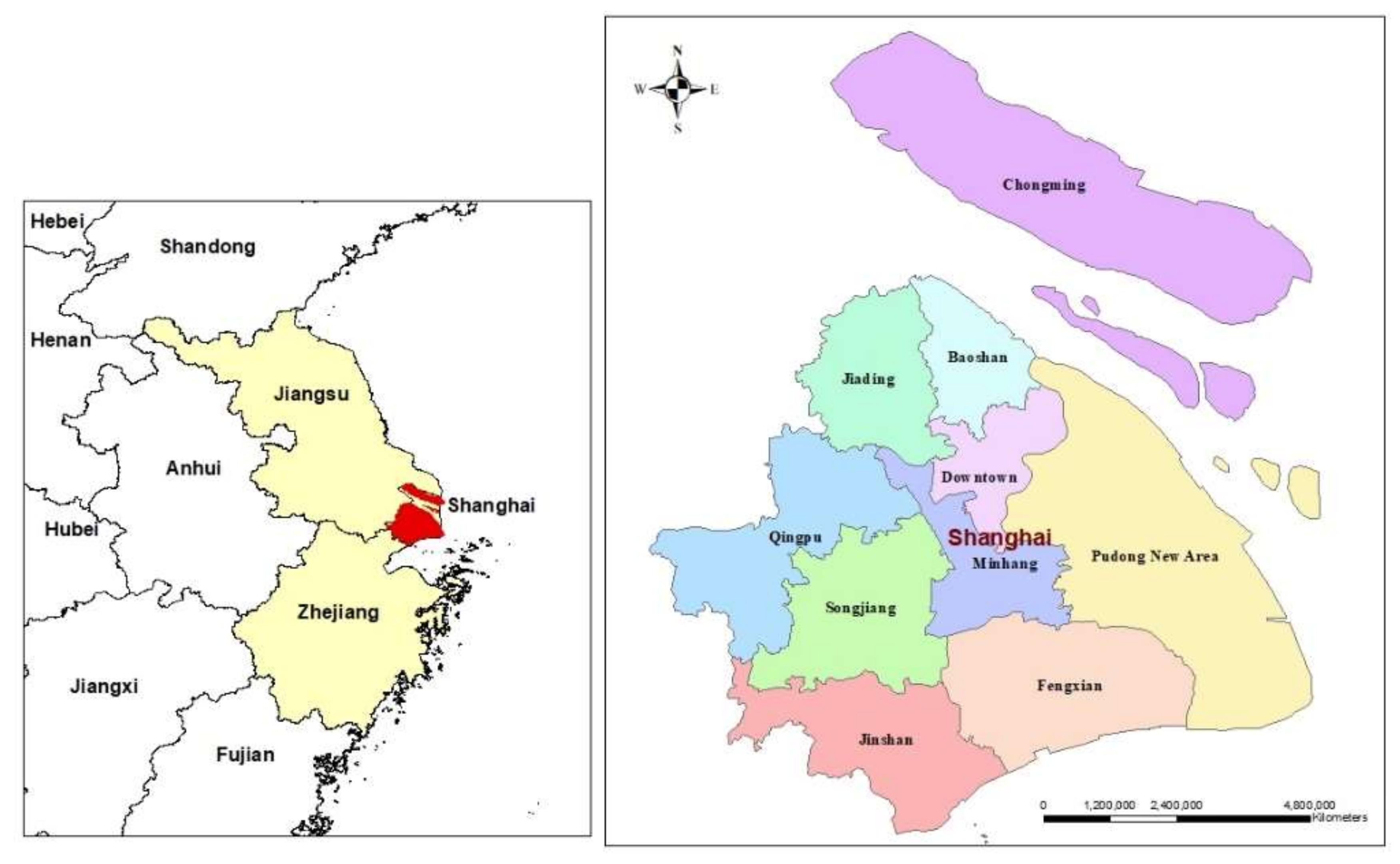
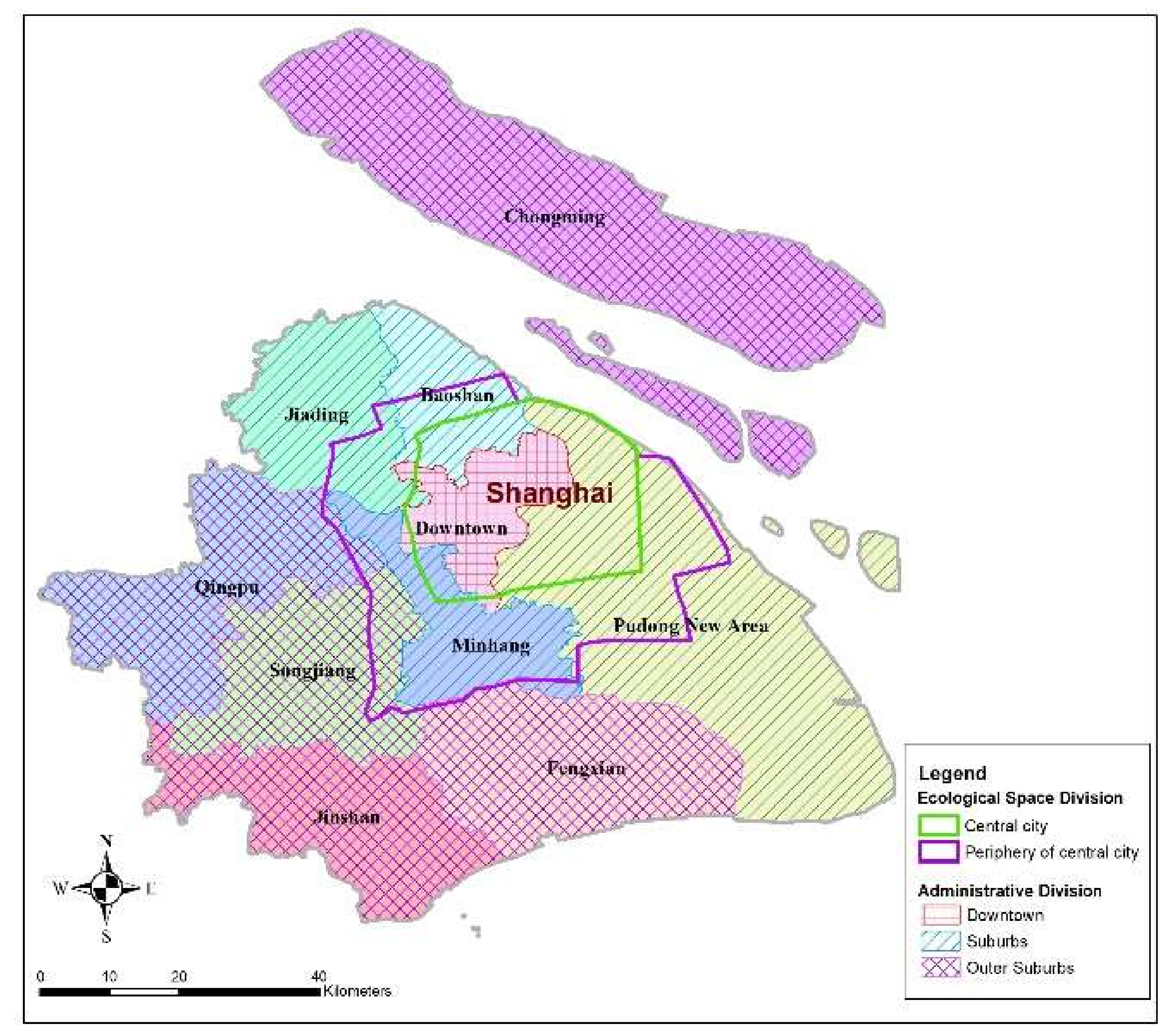
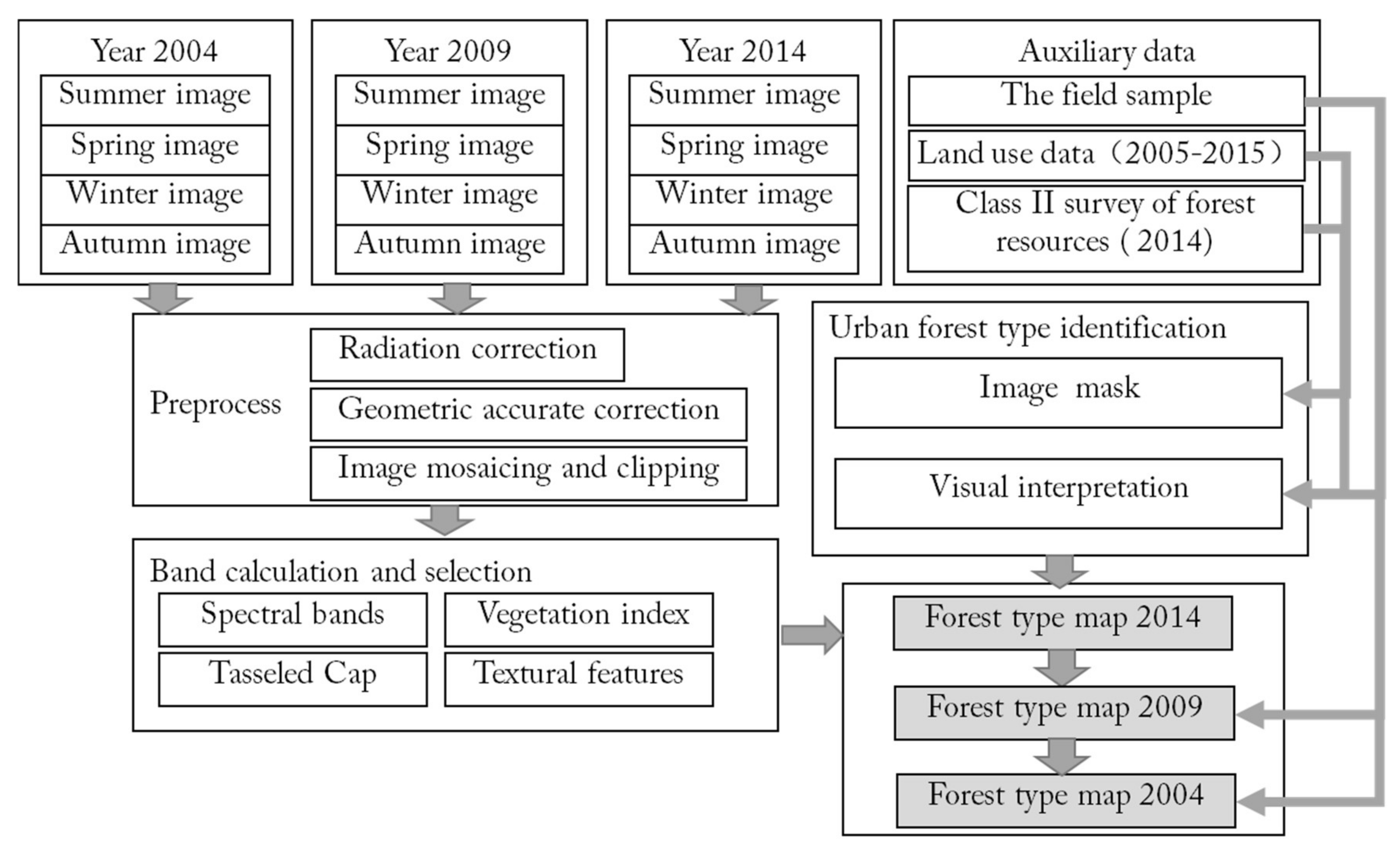
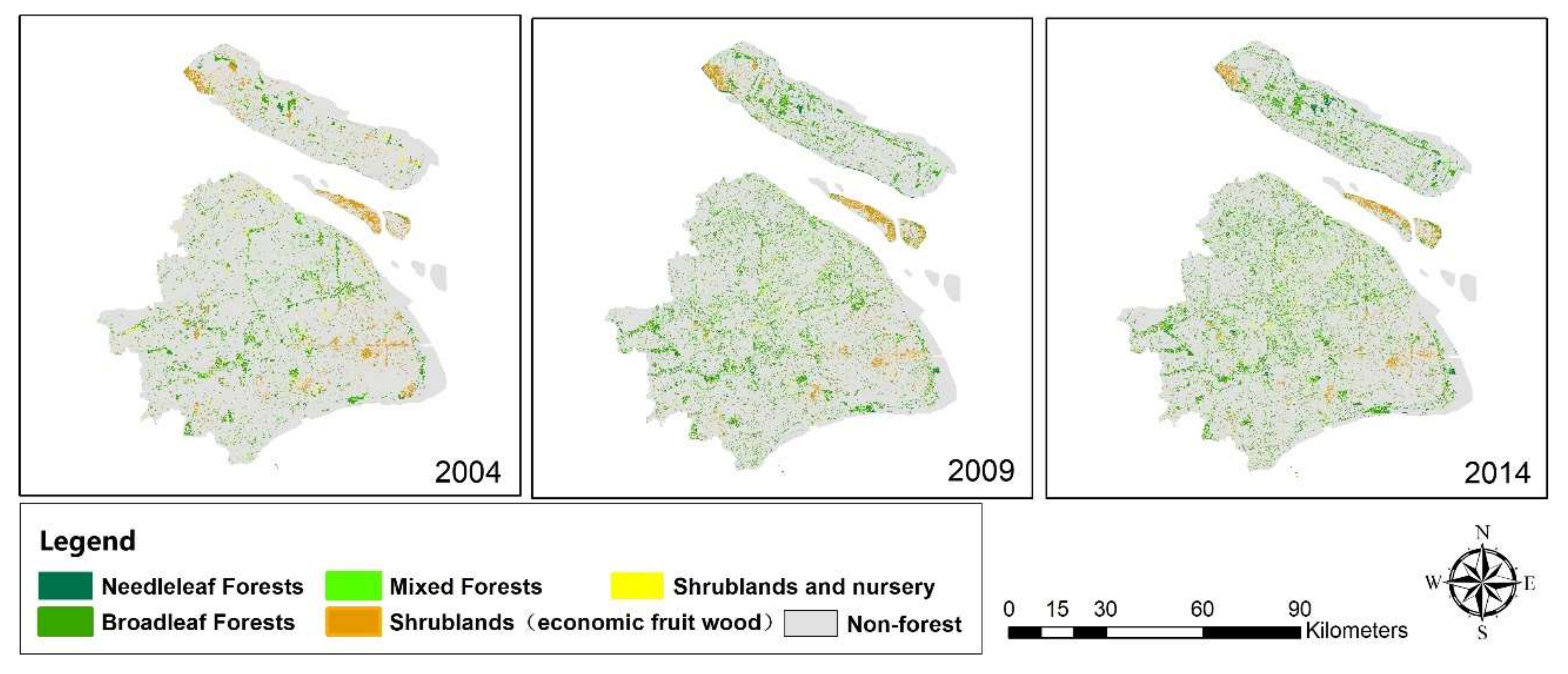


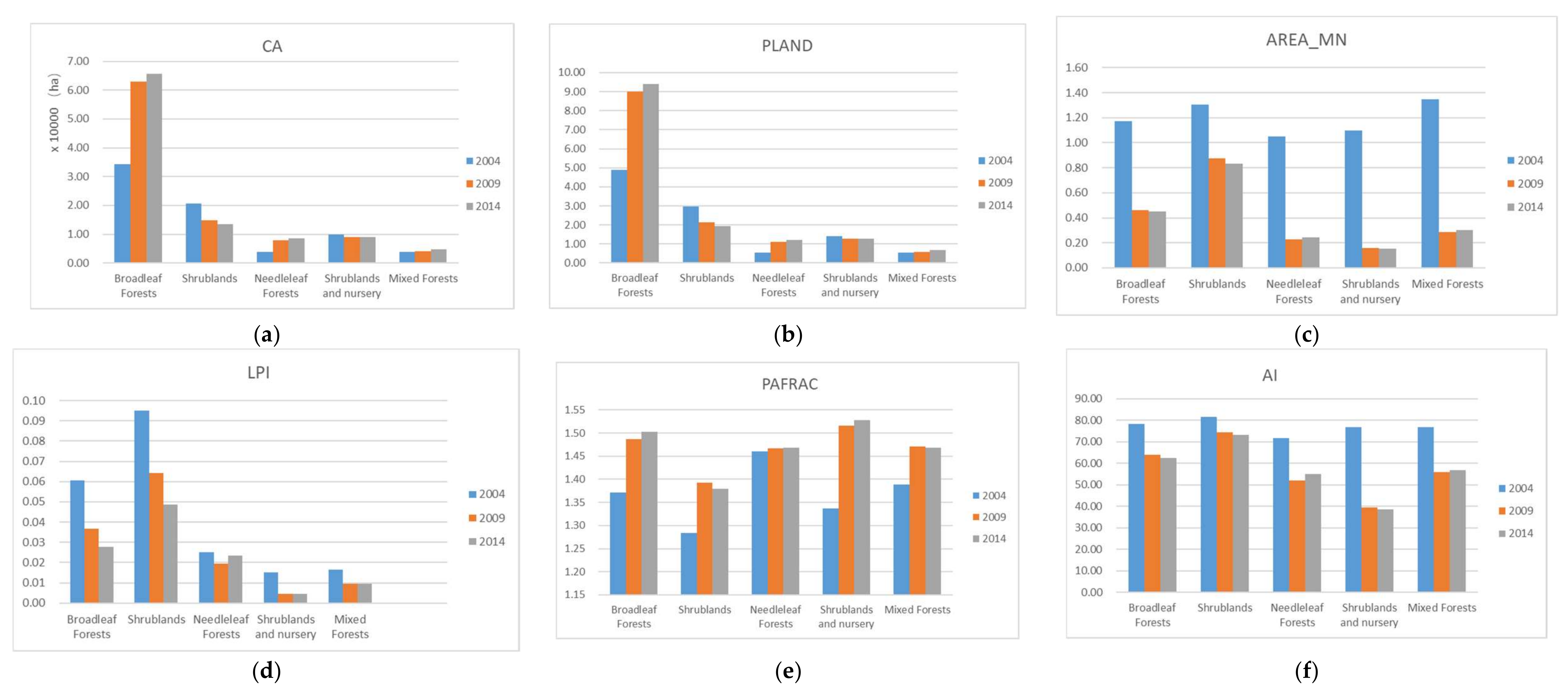

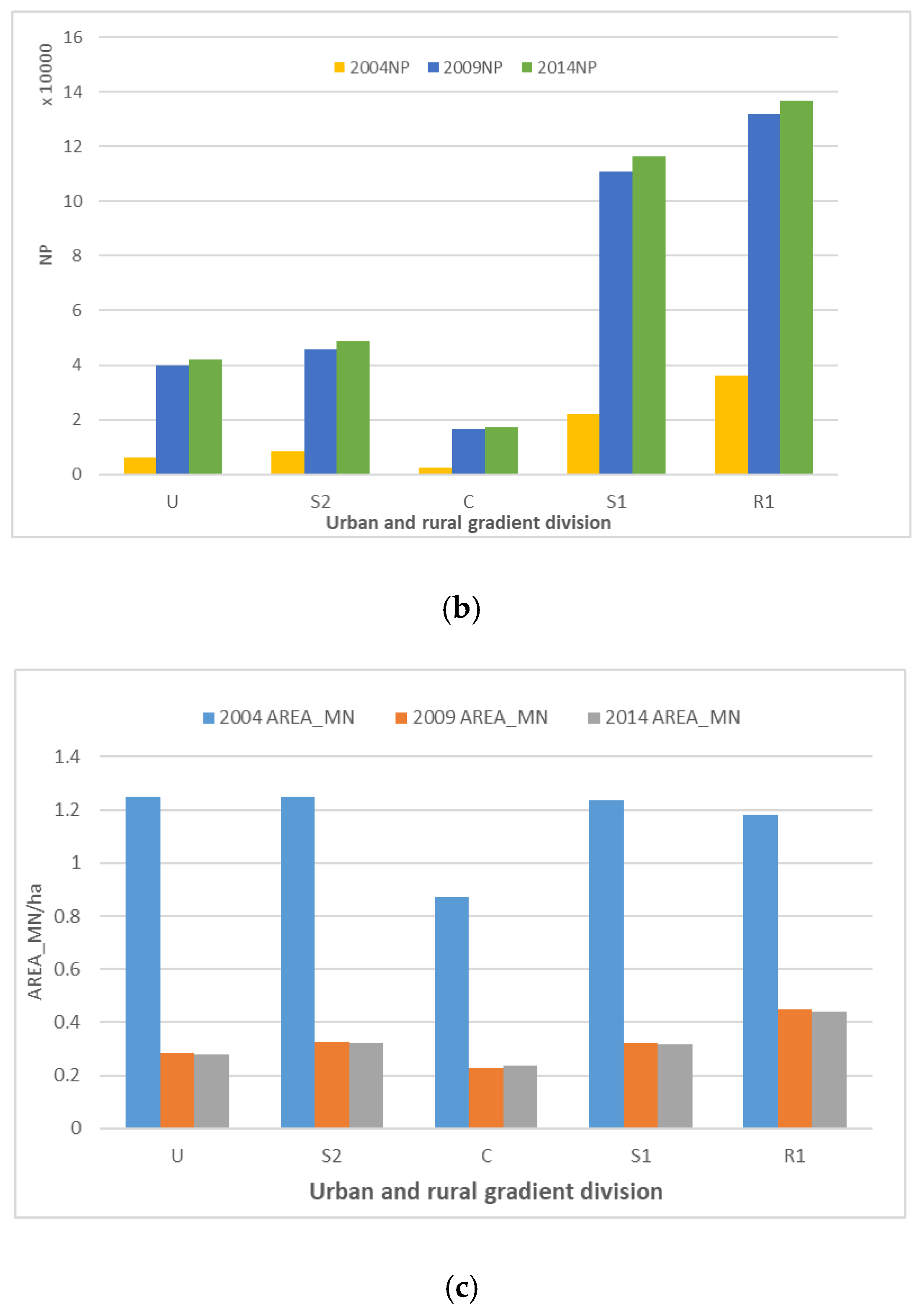
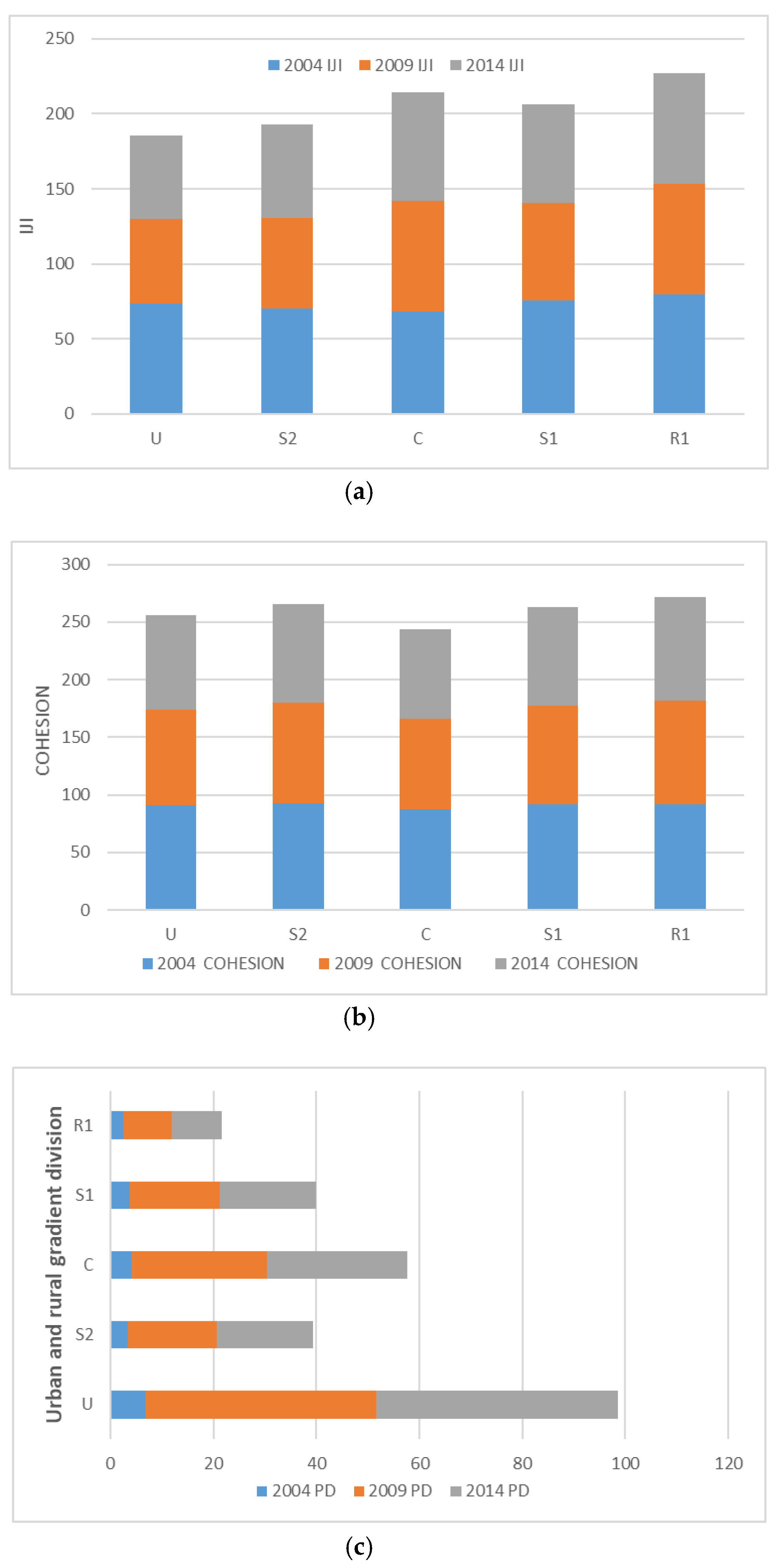



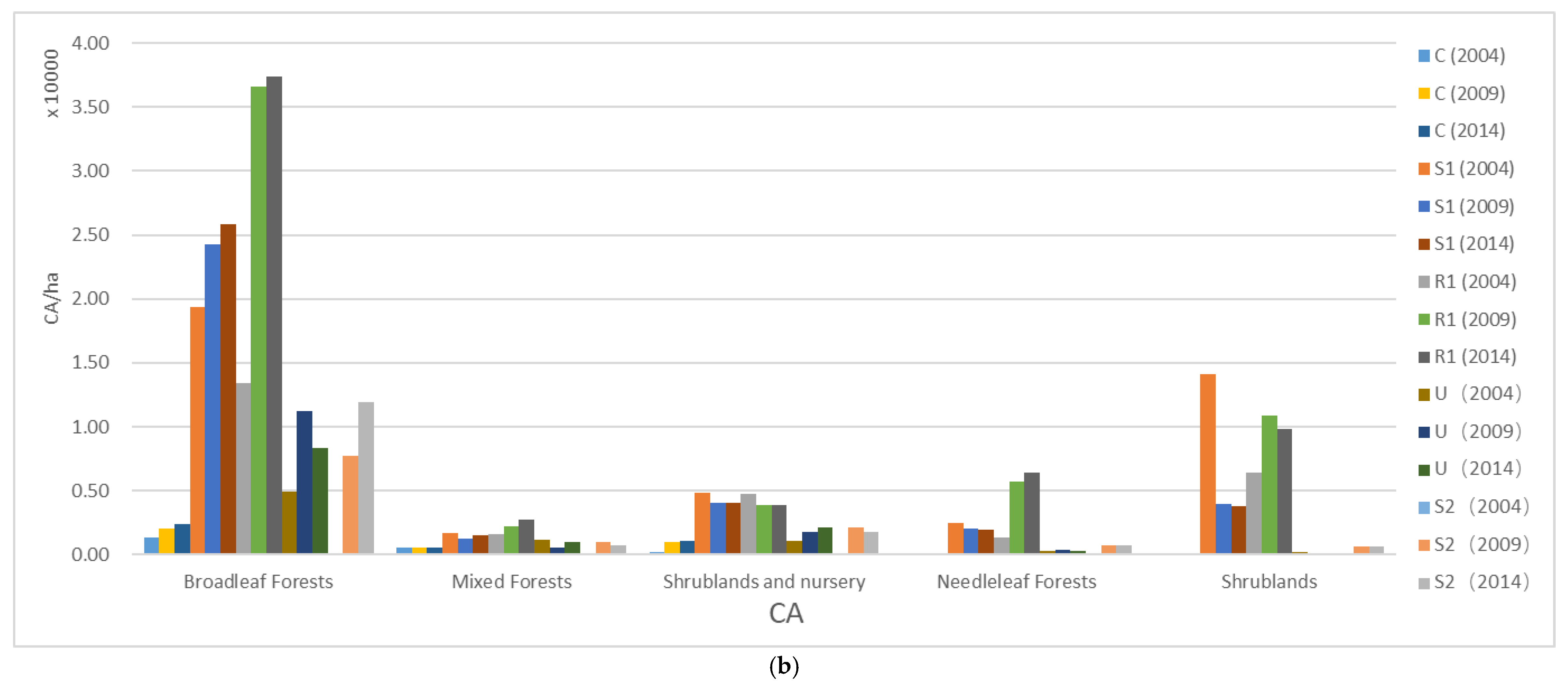
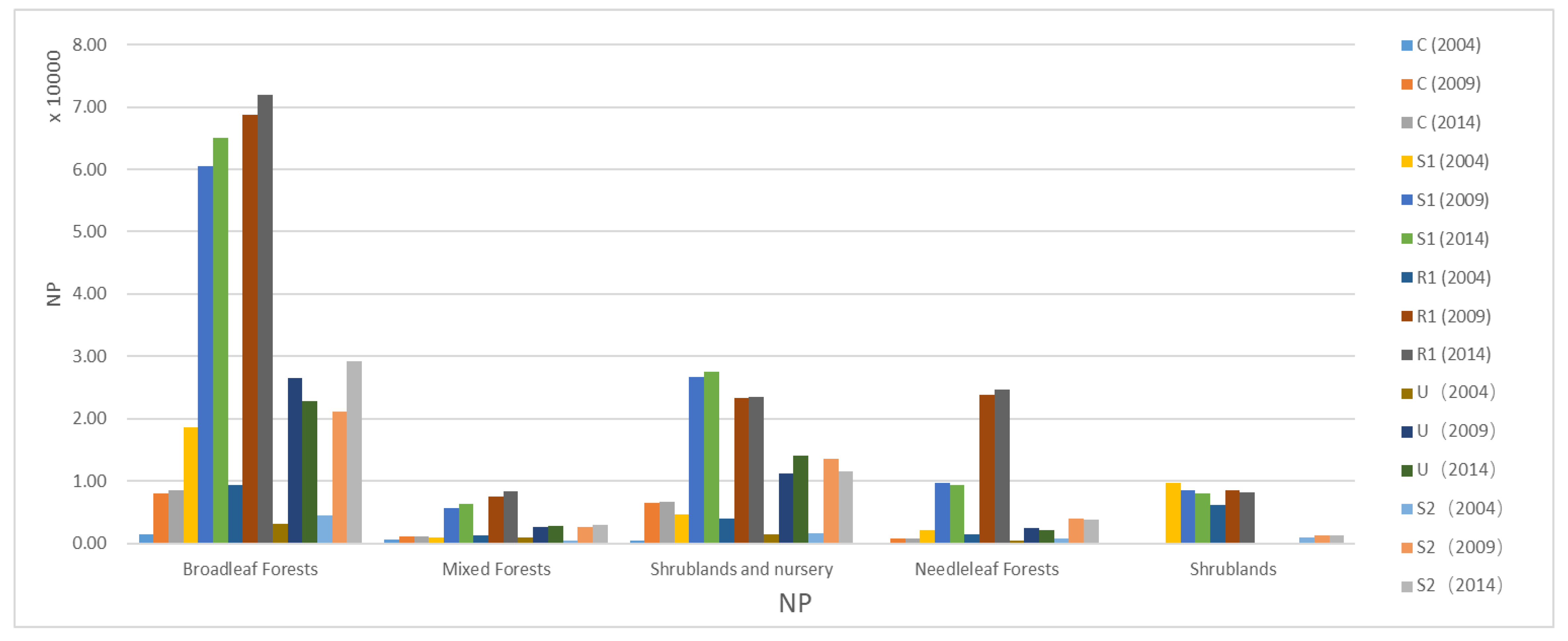



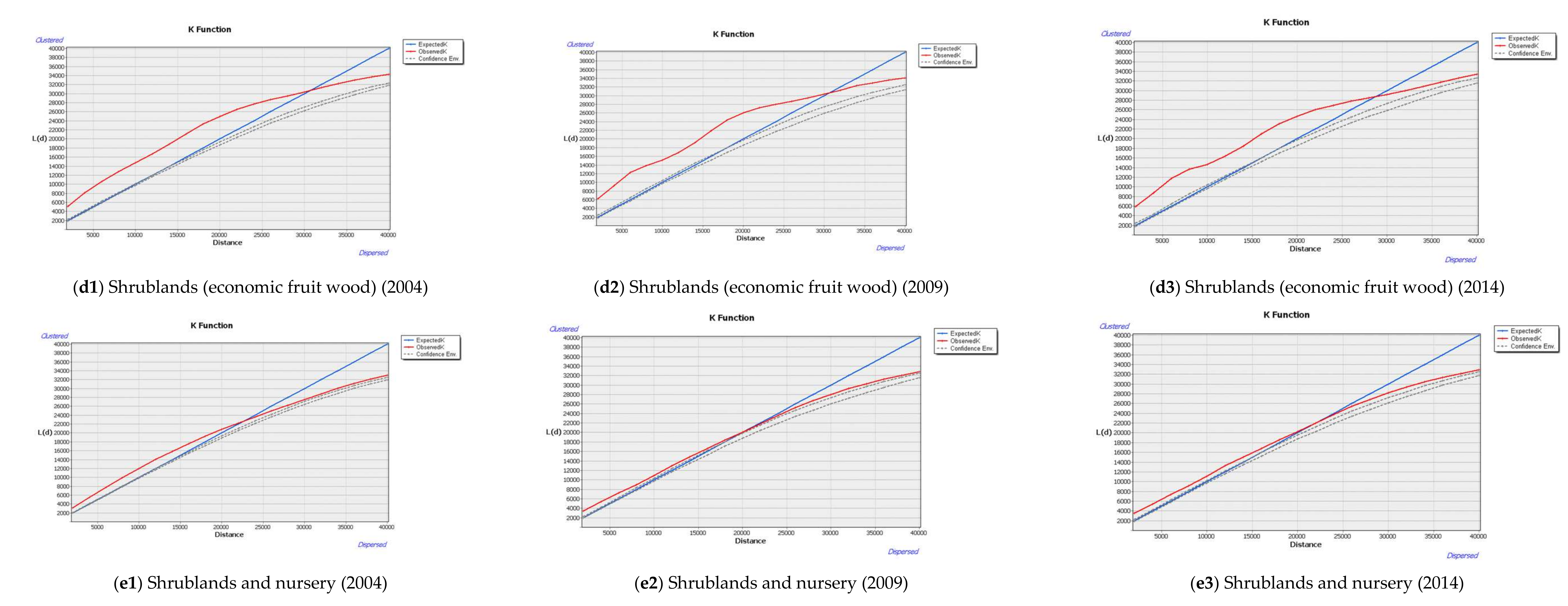

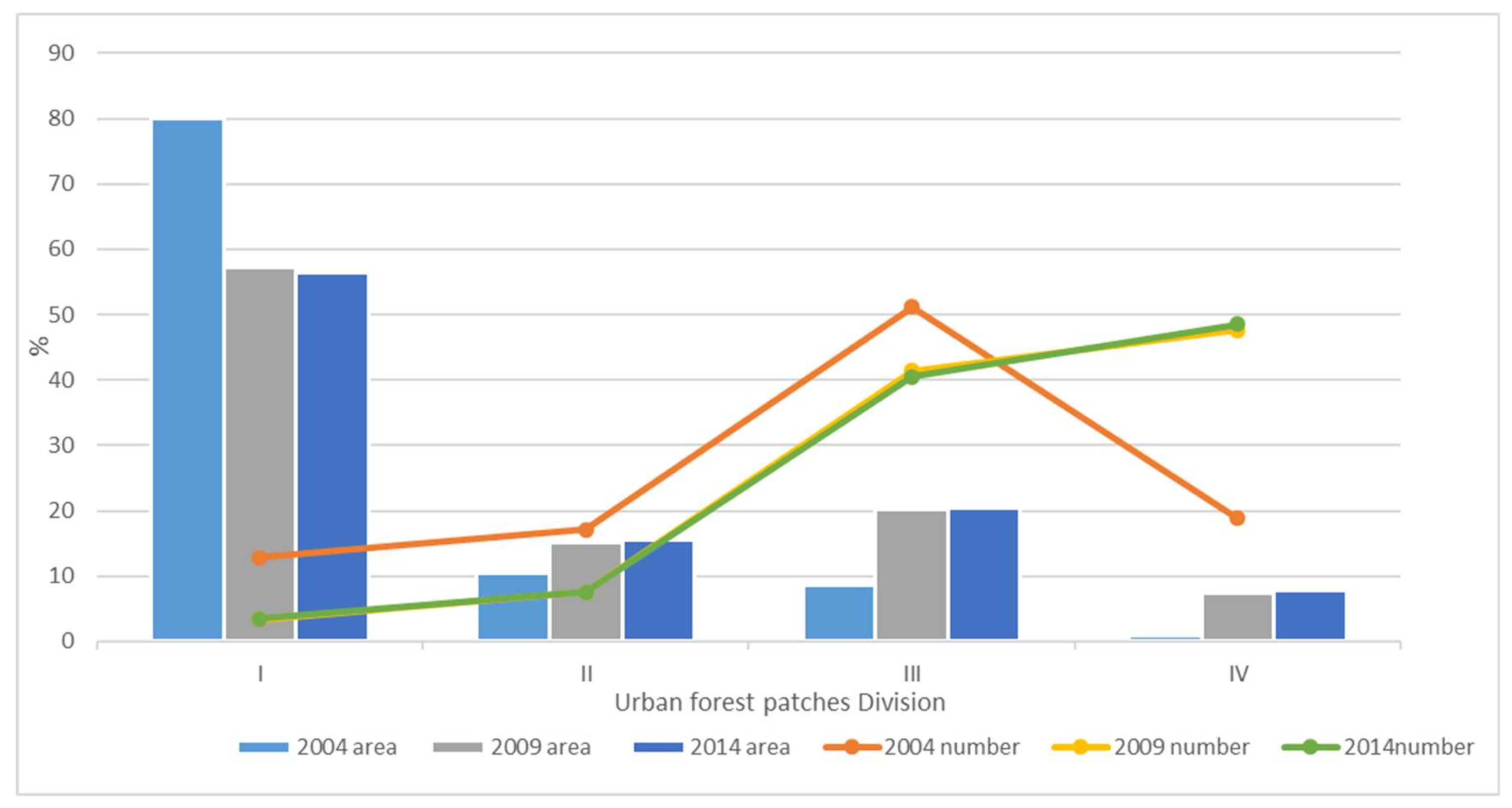
| Division Method. | Administrative Division | Ecological Space Division | |||
|---|---|---|---|---|---|
| Range Name | Downtown (C) | Suburbs (S1) | Outer Suburbs (R1) | Central City (U) | Periphery of Central (S2) |
| Area (ha) | 27,176 | 262,910 | 377,056 | 69,920 | 95,279 |
| Region | Putuo, Yangpu, Xuhui, Changning, Zhabei, Hongkou, Huangpu, Jingan | Pudong New Area, Jiading, Minhang, Baoshan | Chongming, Fengxian, Qingpu, Songjiang, Jingshan | Hongkou, Zhabei, Jingan, Huangpu, Yangpu, Putuo, Changning, Pudong, Baoshan, Jiading, Minhang | Baoshan, Jiading, Minhang, Qingpu, Songjiang, Pudong |
| Landscape Structure | Landscape Metric | Abbreviation | Analysis Level |
|---|---|---|---|
| Area and Edge Metrics | Number of patches | NP | L/C |
| Total landscape area (ha) | TA | L | |
| Class area | CA | C | |
| Largest patch index | LPI | L/C | |
| Percentage of landscape | PLAND | C | |
| Patch area (mean) | AREA_MN | L/C | |
| Shape Metrics | Perimeter-area fractal dimension | PAFRAC | L/C |
| Contiguity index distribution | CONTIG_MN | L/C | |
| Aggregation Metrics | Patch density (#/100 ha) | PD | L/C |
| Interspersion and juxtaposition index | IJI | L/C | |
| Patch cohesion index | COHESION | C | |
| Aggregation index | AI | L/C | |
| Euclidean nearest neighbor distance (mean) | ENN_MN | C | |
| Splitting index | SPLIT | C | |
| Diversity Metrics | Simpson’s evenness Index | SIEI | L |
| Shannon’s diversity index | SHDI | L |
| Area/ha | Land Area | Forest Area 2004/km2 | Forest Area 2009/km2 | Forest Area 2014/km2 | Forest Coverage 2004/% | Forest Coverage 2009/% | Forest Coverage 2014/% |
|---|---|---|---|---|---|---|---|
| Downtown | 28,944 | 2006 | 3617 | 3796 | 6.93 | 12.50 | 13.11 |
| Minhang | 37,168 | 4366 | 6481 | 6900 | 11.75 | 17.44 | 18.56 |
| Baoshan | 28,608 | 2732 | 4673 | 5076 | 9.55 | 16.34 | 17.74 |
| Jiading | 46,390 | 3694 | 5592 | 6444 | 7.96 | 12.05 | 13.89 |
| Pudong | 121,041 | 16,973 | 19,049 | 18,891 | 14.02 | 15.74 | 15.61 |
| Jinshan | 58,605 | 4734 | 6533 | 6950 | 8.08 | 11.15 | 11.86 |
| Songjiang | 60,471 | 7771 | 9733 | 9700 | 12.85 | 16.09 | 16.04 |
| Qingpu | 67,044 | 5270 | 8663 | 8866 | 7.86 | 12.92 | 13.22 |
| Fengxian | 68,739 | 6418 | 8394 | 8767 | 9.34 | 12.21 | 12.75 |
| Chongming | 117,040 | 18,493 | 26,073 | 26,197 | 15.80 | 22.28 | 22.38 |
| Area and Edge Metrics | Shape Metrics | Aggregation Metrics | Diversity Metrics | |||||||||
|---|---|---|---|---|---|---|---|---|---|---|---|---|
| Year | TA | NP | LPI | AREA_MN | PAFRAC | CONTIG_MN | PD | ENN_MN | COHESION | IJI | SHDI | SIEI |
| 2004 | 72455.40 | 60630.00 | 0.10 | 1.20 | 1.35 | 0.39 | 8.68 | 153.98 | 91.73 | 79.46 | 1.30 | 0.84 |
| 2009 | 98807.28 | 259287.00 | 0.06 | 0.38 | 1.48 | 0.19 | 37.06 | 76.93 | 88.38 | 71.77 | 1.12 | 0.69 |
| 2014 | 101586.44 | 270109.00 | 0.05 | 0.38 | 1.49 | 0.19 | 38.60 | 74.78 | 87.56 | 72.54 | 1.12 | 0.68 |
© 2018 by the authors. Licensee MDPI, Basel, Switzerland. This article is an open access article distributed under the terms and conditions of the Creative Commons Attribution (CC BY) license (http://creativecommons.org/licenses/by/4.0/).
Share and Cite
Li, Y.; Xue, C.; Shao, H.; Shi, G.; Jiang, N. Study of the Spatiotemporal Variation Characteristics of Forest Landscape Patterns in Shanghai from 2004 to 2014 Based on Multisource Remote Sensing Data. Sustainability 2018, 10, 4397. https://doi.org/10.3390/su10124397
Li Y, Xue C, Shao H, Shi G, Jiang N. Study of the Spatiotemporal Variation Characteristics of Forest Landscape Patterns in Shanghai from 2004 to 2014 Based on Multisource Remote Sensing Data. Sustainability. 2018; 10(12):4397. https://doi.org/10.3390/su10124397
Chicago/Turabian StyleLi, Yang, Chunyan Xue, Hua Shao, Ge Shi, and Nan Jiang. 2018. "Study of the Spatiotemporal Variation Characteristics of Forest Landscape Patterns in Shanghai from 2004 to 2014 Based on Multisource Remote Sensing Data" Sustainability 10, no. 12: 4397. https://doi.org/10.3390/su10124397
APA StyleLi, Y., Xue, C., Shao, H., Shi, G., & Jiang, N. (2018). Study of the Spatiotemporal Variation Characteristics of Forest Landscape Patterns in Shanghai from 2004 to 2014 Based on Multisource Remote Sensing Data. Sustainability, 10(12), 4397. https://doi.org/10.3390/su10124397





